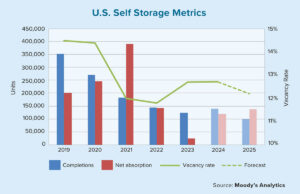When it comes to commercial real estate, the post-pandemic economy has grounded some asset classes while others are now rising stars. Multifamily and industrial are two sectors proving especially resilient to recent economic hardships. Hospitality and office, not so much.
Meanwhile, store closures and a consumer base hooked on e-commerce have caused retail vacancies to climb. Property values are lagging by comparison and investors are eager to grab up the deals. Like the adage, when one door closes, another door opens, and adaptive reuse is helping old buildings to find new life. The idea of rehabilitating and repurposing a property rather than building a new structure from the ground up is gaining popularity.
The prevalence of storefront retail we once knew may not return. Office workers now have a taste for working at home, leaving behind underused spaces. Empty warehouses are blank canvasses, primed to better serve today’s consumers. Property owners can view the changing landscape as a loss or they can seize the opportunity to convert their buildings into better uses.
Through adaptive reuse, these real estate investments can find new life and become better insulated from future economic downturns.
Adaptive-reuse financing requests are growing increasingly more common. But as dynamic and synergistic as this emerging market is shaping up to be, there’s an elephant in the room: Lenders don’t like risk. And adaptive-reuse deals are risky.
This risk will dictate financing terms — from interest rates and loan-to-value calculations to the documentation required to close the deal. To get such deals approved and funded, commercial mortgage lenders, brokers and borrowers alike will want to do their homework and preempt foreseeable obstacles.
Creative uses
Adaptive reuse can be as simple as redividing retail spaces and expanding them into mixed-use properties. Or it can be as dramatic as purchasing a vacant shopping mall and turning it into multifamily housing.
One borrower, for example, broke up an underperforming big-box store to create smaller units for family-focused retailers. Someone else converted an empty warehouse into space for cannabis sales and cultivation. And yet another entrepreneur transformed a vacant shopping center into church offices and meeting spaces.
Adaptive reuse allows developers to get creative. A borrower recently converted a defunct auto dealership into high-end apartment lofts. By leaving the original exterior signage in place and adding interior garage doors, the client created a buzz about the property and preleasing was a snap.
The greatest challenge in funding adaptive reuse is the lack of verifiable income or cash flow.
These projects, however, do come with difficulties. One of the unique challenges is the likely need for rezoning. If a borrower approaches a lender while preliminary zoning approval is pending, it will be an uphill challenge to get funded. Even in cases where the lender is willing to move forward, the financing terms may be impacted by the contingency.
Similarly, industry regulations may affect potential income. Multifamily is the most popular property type for repurposing today, given the persistent strength of the rental market, so it serves as a good example. Local occupancy limits or restrictions on short-term rentals may not only dampen the lender’s enthusiasm, but these limitations also may require borrowers to rethink their income projections.
Planning ahead
There is little a lender can do to resolve issues such as rezoning delays or regulatory restrictions. Lenders should advise borrowers that the best way forward is to work through these issues during the purchase negotiations or at least prior to bringing the deal to the lender.
If the borrower has an all-clear sign on these issues, it may help to present this information to the lender. Not only can this speed up approval, but it shows that the borrower has a level of expertise in the industry, which goes a long way toward generating lender confidence.
Income potential must be carefully researched before presenting the deal to the lender. Once again, using multifamily as the example, market rent comparisons won’t be enough. The lender will want to know the absorption rate for the specific submarket. How many units are available and how quickly are new units likely to become occupied?
Cash-flow conundrum
The extent of renovations proposed by the borrower also comes into play. When the improvements to the property are projected to cost more than the purchase price, for example, the lender may treat the deal as a construction loan.
Lenders prefer to see construction costs below 50% of the property’s appraised value or purchase price. Anything higher than that may still be fundable, but the interest rate, term and loan-to-value (LTV) ratio will be impacted. The renovation budget also must be realistic. The more detailed the better when presenting the deal to the lender.
These considerations aside, the greatest challenge in funding adaptive reuse is the lack of verifiable income or cash flow. When income projections must be estimated from market sources and industry comparisons, borrowers who want to repurpose a commercial property face an uphill battle when seeking financing, especially when it comes to low-interest, long-term loans.
Lenders want to see stabilization and 12 months of cash flow before entertaining a deal on terms most appealing to the borrower. And this leaves many investors frustrated when it comes to financing adaptive-reuse projects. But the answer may involve a little patience and perseverance.
Two-step strategy
Borrowers may want to consider a two-step, two-year funding strategy when approaching adaptive-reuse projects. The first step is to seek short-term bridge financing, which solves the immediate need for cash to purchase and renovate the property.
A bridge loan generally does not require the same income statements or levels of documentation as long-term financing options. Nor does the bridge loan require the property to be stabilized or income producing at the outset. For these reasons, the bridge loan may close more quickly, which is a great advantage for many borrowers, especially when seeking to purchase an underperforming property.
With bridge financing in place, the borrower can purchase the asset, complete the necessary renovations and quickly begin to generate income. Once the borrower records 12 months of income, lenders will be more amenable to refinancing to a low-interest, long-term loan.
By approaching the financing piece in this fashion, the borrower has the initial funds to acquire or renovate the property. After that, they become better positioned to receive the best available interest rate and LTV ratio via long-term financing.
Proactive approach
Another advantage of this two-year plan is the recapturing of equity. The LTV for a refinance can be calculated on the new appraised value for the property once it is producing income.
Typically, this value is going to be much higher than the alternative calculation, which is the purchase price plus renovation costs. Not only can the borrower qualify for a higher funding amount, but they also may be able to cash out more equity. By taking this measured approach, a borrower is more likely to end up with premium financing compared to someone who shoots for the stars and holds out for best terms at the onset of the project.
Mortgage brokers who take a proactive approach are the most likely to get deals into the pipeline. Lenders seldom pore over the borrower’s documentation in search of deal viability. Spreadsheets don’t always tell the story.
Fitting pieces together
An example of a broker taking initiative is evident in the case of a borrower seeking to purchase a defunct hotel and turn it into office suites. On the face of it, this was a proposal for an adaptive reuse from a depressed asset class into a slightly less depressed asset class — not the sort of deal that lenders fight over.
An astute broker knew this. He fit the pieces together and laid out the path forward. The borrower was moving his business out of a tier-one rental market, purchasing an underperforming building in the suburbs and repurposing it into owner-occupied office space so that he could afford to grow his workforce tenfold. The cost savings coupled with the projected income gave the deal legs.
To support the narrative, the broker submitted relevant documentation based on specific and detailed submarket matrices. The numbers were there. As of earlier this year, the deal was under serious consideration even though it previously had been turned down by two other lenders.
● ● ●
Regardless of asset class, commercial real estate remains a solid investment. And commercial mortgage financing continues to offer advantages over unsecured business lines or equity financing. Through adaptive reuse, these real estate investments can find new life and become better insulated from future economic downturns. ●
-
Dan Page is the president of Boulder Equity Partners. He has worked in the financial-services industry for 25 years and has been a direct lender since 2008, helping small-business owners nationwide secure the growth capital they need while helping to save money by consolidating expensive debts. Page has spoken at conferences around the world, teaching marketing- and business-development strategies to senior executives in the financial-services and internet-marketing industries.
View all posts








